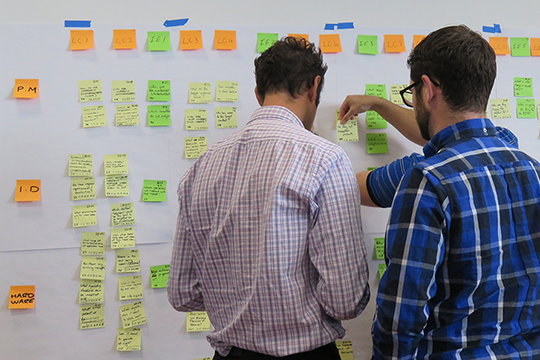I’ll never forget the week of March 9, 2020. For us, that was the week that everything changed. In that week, we cancelled all of our face-to-face workshops for 2020. I also agreed to facilitate my own first virtual Kickoff Event.
The workshops are central to our ability to build enough working knowledge about Rapid Learning Cycles that a team can be successful with them immediately. Moving them online was not going to be easy since we needed to ensure that we could achieve the same results with a virtual experience.
We immediately used the Virtual Kickoff Events as experiments to figure out whether or not that would be possible, and how. An early Key Decision was establishing a partnership with Cardsmith as the virtual collaboration tool we found that best replicated sticky note brainstorming in person. Other tools added flexibility but also complexity — and had much steeper learning curves.
We all hoped this would be temporary. We looked forward to the day when I’d be able to teach the workshops and meet with clients face-to-face. It was clear what we’d lost. But we didn’t know what we’d gain from a year of Virtual Rapid Learning Cycles.
Five Benefits of Virtual Rapid Learning Cycles
Out of all this activity, we learned that there were benefits as well as drawbacks to virtual work. Our kickoff events were rough at first, as we worked out the differences between virtual and face-to-face Kickoff Events. The flow was different in some important ways. It took me time to learn how to maximize my ability to use the tools, and how to manage a large-scale virtual event. But I noticed right away that some things were just better.
Today, I know that we can achieve similar results with a virtual Kickoff Event. In fact, I think that we will see better results from the virtual workshops, because virtual Rapid Learning Cycles have at least five major advantages over face-to-face events.
Virtual events can be more inclusive and more global.
The first event I facilitated involved people from three different states. The second had people from three different countries on two continents. My first workshop in 2021 has people from five different countries. If I had to choose one location for these, it would have been the UK. The US people would probably not have joined us, and half of the rest would have to travel.
All that travel has costs: financial costs, environmental costs and personal costs. Some people cannot travel due to family obligations or disabilities that make travel much more difficult. Yet there is nothing to keep them from joining a virtual event. In the future, our guidance will be that if the team doesn’t have another reason to meet face-to-face, then there is no need to travel for the Kickoff Event, as long as the team has a good collaboration environment and they are willing to work in separate spaces so that everyone experiences the event in the same way
Good virtual tools make the Kickoff Events flow better than a face-to-face event.
We use Zoom and Miro now for our Virtual Kickoff Events. We use Zoom because it has excellent breakout room features that make it easier to manage a large group. They’ve addressed the security concerns that plagued them in the early days of the pandemic, and now reliability is just better and better with every release. We use Miro because it has a short learning curve, works reliably and doesn’t do anything extra that only clutters the views we need. Their support has been outstanding. The combination means that I don’t have to think about technology — it just works.
With this combination, I’ve run Kickoff Events for up to 30 people and I think I could probably handle twice that number without losing quality. People can work in small groups and then we can bring them together, but unlike in a physical environment, they can all see the boards clearly — much more clearly than they can if they are looking at paper sticky notes from a distance. This makes the discussion more focused and relevant.
The Kickoff Event facilitator can be a more effective coach in a virtual event.
Facilitators also benefit from the ability to see everything at once. I don’t have to hover or try to read sticky notes from far away. I can spot when someone’s in trouble a lot faster and I can redirect them a lot faster via a quick cell phone call. I can see when a team needs help and when they’re ready to move on. I’m not doing anything that I can’t teach a program manager how to do — it’s just easier because everything is so much more visible to me.
As a result, the teams get better outcomes. A person who needs help gets that help faster. A person who’s misunderstood something gets redirected faster, so that they have less rework to do, and less frustration at having to do it. Teams that are having a problem can push the “Help” button to let me know, and I can go right to them so that they don’t waste time being stuck.
Large events are actually better in a virtual setting than a face-to-face setting.
In a large face-to-face meeting, facilitators struggle to monitor everything that’s happening by walking from table to table and squinting at post-it notes from a distance. In a large group, that’s magnified, requiring co-facilitators to help monitor the group and coach people who need it. I need to find or bring experienced people to keep teams on track.
In a large-scale virtual event, I can see all of the boards at once, and I’ve learned how to interpret what I see so that I can quickly spot trouble or an opportunity to improve the outcomes. It helps to have at least one trained person in each breakout to keep their team on track, but that person doesn’t have to be a fully-trained facilitator — it’s enough for them to have program manager-level training and a little experience with Rapid Learning Cycles — but not a lot — because I can spot problems and opportunities, and go where I’m most needed faster.
We get better outcomes from a series of sessions rather than a single offsite.
Finally, face-to-face events are normally held in a conference room or even off-site, and in a single day. We learned right away that we couldn’t do it virtually. People get tired faster. In truth, they got tired in a face-to-face meeting too but the limitations of scheduling travel meant that we just pushed through it.
We normally break Virtual Kickoff Events into two sessions, with a third training session for anyone who is new to the process. We learned that rather than breaking up the flow, it actually helped get better results. Controversial issues can be taken off-line in between sessions by the people who need to work things out, so that the rest of the group doesn’t waste time on things that are not relevant for them. The time spent reflecting on Key Decisions overnight leads to better Knowledge Gaps and a better Learning Cycles Plan. There is time to research questions that arise or get quick feedback on direction from sponsors before the team meets again.
Virtual Rapid Learning Cycles Deliver Strong Results
All of this means nothing if the plans are not solid. We look at things like the percentages of Key Decisions Closed On Time and of High Priority Knowledge Gaps Closed Before Their Key Decisions, as well as the amount of re-planning that has to be done after the event — to gauge whether or not Rapid Learning Cycles are healthy. The teams we followed in 2020 had outcomes that were similar or better than the outcomes from teams we’ve followed in the past, in spite of the challenges from the pandemic.
Looking back on some of the larger events I’ve done in person and the challenges those teams had, I think they would have benefited from a virtual experience that would have helped the teams receive better coaching during the event and leave the event with a stronger common understanding of their plan.
If you want to learn how to run Rapid Learning Cycles virtually, visit our Rapid Learning Cycles Global Project Leader Certification Workshop page. Certified Professionals can join this class at a reduced rate to upgrade their certification.



